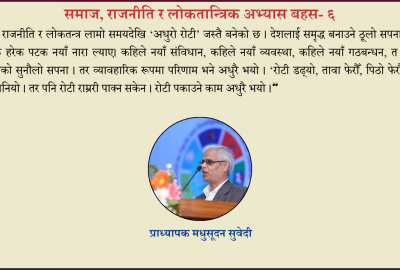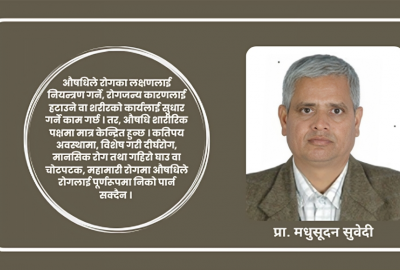Reassessing the Panchayat rule
2021-10-01Autocratic Monarchy provides an insightful glimpse into the workings of the Panchayat polity
Pranab Kharel
The 30-year party-less Panchayat period is considered one of the most important phases in our recent history. Even though Nepali nationalism can be traced back to Prithvi Narayan Shah, whose military campaign in the 18th century unified various principalities, the Panchayat period shaped a particular ‘national identity’ that remains contested today. And a lot of grievances against the Nepali state—especially from marginalised groups such as Janjatis, Madhesis and Dalits—have their roots in this period.
Founded on the idea of having a system ‘suitable to the soil’ by king Mahendra, the Panchyat polity was marked by a party-less system that emphasised decentralisation while class coordination was to be implemented “only through active and dynamic leadership of the crown.” Mahendra dismissed the first ever democratically elected government of BP Koirala and the Panchayat polity’s legacy has had a lasting impact on Nepal’s history. The Panchayat equated nationalism with the Nepali language, daura suruwal and Hindu religion. It led an aggressive campaign to mould a Nepali identity along these lines. However, the institutions and policies of Panchayat were riddled with contradictions.
All this makes the Panchayat era an important period in Nepali history but little literature on it is available. As an attempt to fill this void, Martin Chautari has come out with Autocratic Monarchy: Politics in Panchayat Nepal. A collection of the works of Leelanatheshvar Sharma Baral, Autocratic Monarchy has been edited by Pratyoush Onta and Lokranjan Parajuli and is divided into 13 chapters. The book uncovers various facets of Panchayat rule, including the 1959 constitution and class organisations that were vital for the system. Baral—a scholar of modern Nepali politics and literature—offers incisive analyses of the Panchayat, especially under Mahendra.
Even though his primary interest is in literature, Baral offers valuable insight into the working of the Panchayat state. The historical trends pointed out by Baral in the run up to the ‘coup’ by Mahendra bear a striking resemblance to political events unfolding at present. Endless bickering among parties, Baral argues, provided grounds for the royal takeover back then. Making a scathing comment on the parties, Baral writes, “To be sure, from their action and intransigence, they almost invariably showed that they were uneducated in the art of accommodation and amity, rationality and restrain.” He further argues that the “resultant political instability obstructed all-round development during the interim period.”
Another striking issue pointed out by Baral is regarding the continuation of the social agendas of the Koirala government that the king had dismissed, citing a breakdown in the law and order situation. Even though the king promised to follow a democratic path after the takeover, what emerged was a “closed, discretionary and patrimonial monarchy.”
Throwing more light on how the new order was being consolidated, Baral provides an analysis of the ‘structuring’ of the state through 14 zones and 75 districts. Highlighting the tour commission formed by the king, Baral interprets this as Mahendra’s attempt to gain public support. But the regime, he says, used drastic decrees to ward off anti-government activities. Accounts provided by Baral point towards a police state where parents handed their children over to authorities for being involved in ‘anti-national’ activities. The analysis offered by Baral on different class organisations formed by the Panchayat also gives a glimpse into its workings. Formed after Mahendra banned political parties, the class organisations were supposed to articulate the interest of the groups they represented—the peasant and youth, among others. However, Baral rightfully questions the utility and purpose of such organisations supposedly formed for galvanising national energy. However, these organisations could not serve this purpose as they were officially controlled—first under the National Guidance Ministry and later under the Home and Panchayat Ministries. Instead, they served as a mechanism to control different sectors of society.
An important aspect of Panchayat rule was the absence of space for dissent. It is interesting to note that the emergence of the middle-class towards its end led to increased contradiction, resulting in the collapse of the system. Baral offers a distinct analysis of the ‘reform period’ after Birendra succeeded Mahendra. Running against the popular belief that Birendra was pro-liberalisation of the state, Baral argues that the regime became more stringent following the constitutional amendments of 1975. The suggestions of the Constitutional Reform Commission formed by Birendra were heavily in favour of the Panchayat, so much so that the graduate constituency, formed earlier to ensure national elections, was removed.
Baral also writes on the foreign policy during the Panchayat regime. Taking advantage of the prevailing geopolitical situation, Mahendra consolidated his regime. Baral convincingly argues that in an attempt to reduce Indian influence, Mahendra forged close association with China and Pakistan. According to Baral, India followed an appeasement policy towards Nepal from 1963 to 1971 as it feared Nepal would move too close to China. Another important foreign policy was that of non-alignment, which the regime used perfectly to its advantage at international, regional and national levels.
The book provides a useful insight into the workings of the Panchayat polity, although more detailed analysis on elite formation—not merely of political leaders—is absent. While Autocratic Monarchy offers plenty of explanations on how political forces made to co-opt or else were banished, a chapter on the whole middle-class formation during the Panchayat era would have improved the overall tenor of the book.
TheKathmanduPost-21Sep2012








